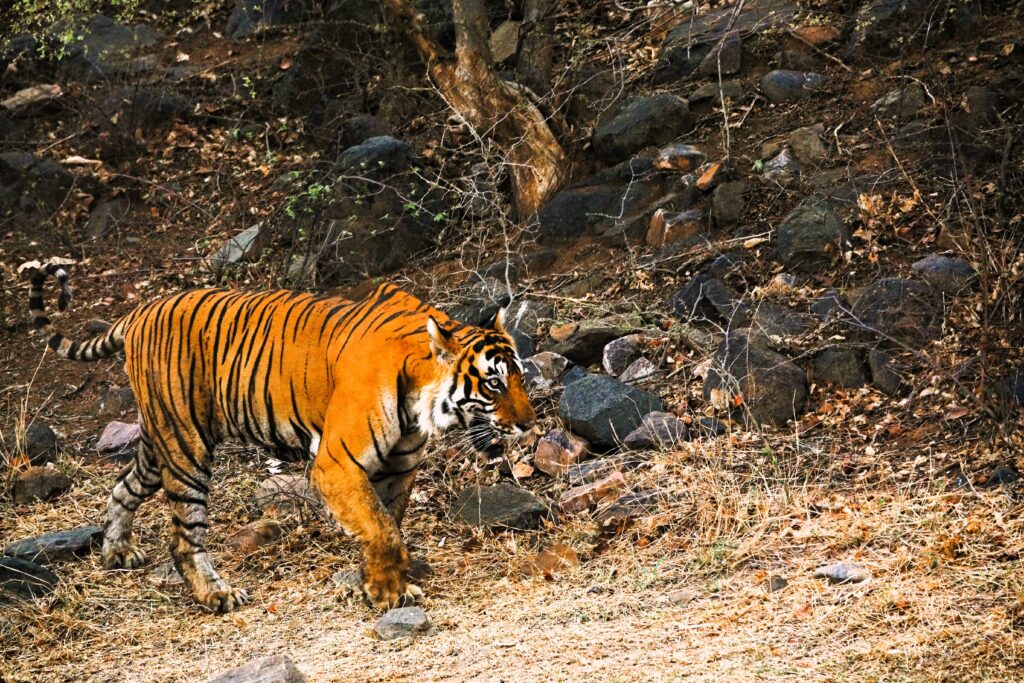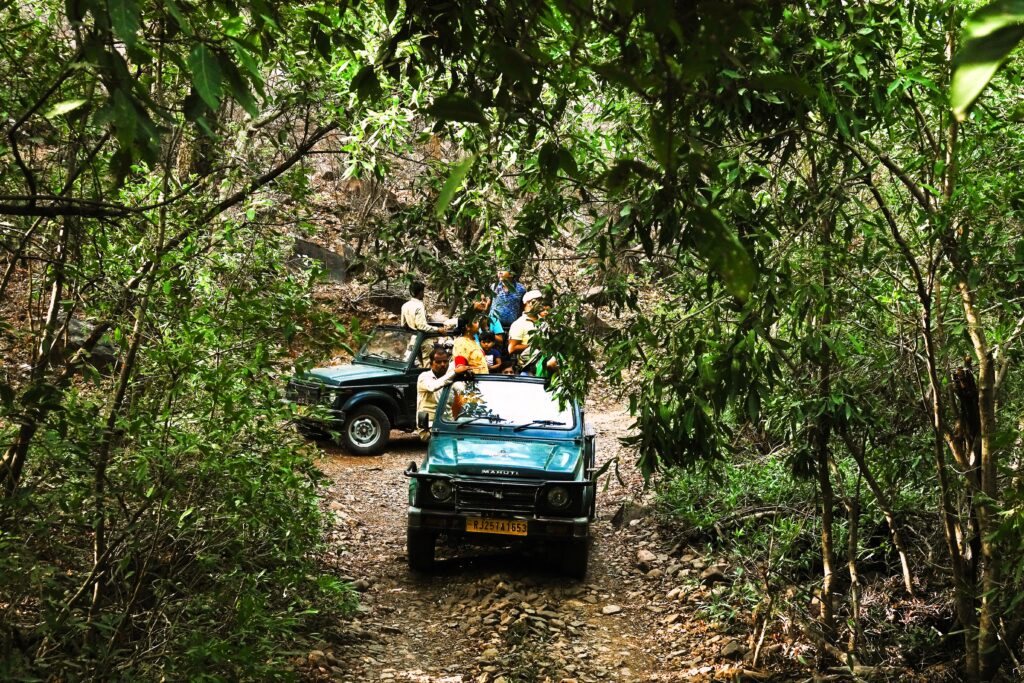
Photographs and text are by N Shiva Kumar
Having visited numerous tiger sanctuaries over the last 40 years starting with Tadoba in Maharashtra, Periyar in Kerala, and Corbett in Uttarakhand in 1984, 1987, and 1991 respectively, I fell in love with the tantalizing Tiger.
After those first encounters, I have been regularly visiting 37 of the 55 Tiger Reserves in India. Most of the time we do not encounter a tiger. The big cats are wild and free-roaming in their territories.
Being close to Delhi and Jaipur, Ranthambhore is easy to approach but difficult to get a safari jeep or even a seat on a canter in the peak season. My recent trip was in June/July (last year) before the rains arrived as many of the sanctuaries were shut down due to the monsoons. In zone ten we encountered a lazy tiger lolling in its puddle of slush to keep its cool from the sizzling heat of 44 degrees. As usual I shot as many photographs as possible from all possible angles with my three cameras in tow.

Tigers are the most magnificent big cats on our planet compared to all other big cats of the world. The powerful apex predators, tigers symbolise supremacy, strength, and stealth in their lifestyle. However, they are also the most endangered species in the world with less than 4000 left in the wild in India spread over 78,735 sq km of tiger habitat. Despite significant conservation efforts, the primary threat to tigers remains habitat loss, low prey base, poaching, and illegal wildlife trade. Anthropogenic activities making inroads into prime forests is another flaw and, in this context. Tourism has emerged as a potentially powerful tool for tiger conservation.
Tiger tourism in India has become a significant attraction in recent years. Ecotourism focuses on observing and appreciating tigers in their natural habitat, offering numerous benefits beyond the thrill of seeing these majestic big cats roaming free in the wilderness. The positive impacts of tiger tourism in India are multifaceted, encompassing conservation, economic growth, and community development around these sanctuaries and national parks. The main purpose of tiger tourism is to promote conservation efforts and raise awareness about the endangered status of tigers. Tiger tourism activities can take many forms, ranging from guided jeep safaris and walking tours to elephant-back rides as in Dudhwaand and even boat trips as in Periyar.
Conservation efforts
One of the primary benefits of tiger tourism is its contribution to wildlife conservation efforts and the income it derives from tourists. The presence of tourists in tiger reserves and national parks creates a financial incentive to protect these areas which in turn has a positive cascading effect on other denizens in the wilderness.
Revenue generated from tourism is often reinvested into conservation programmes, including anti-poaching patrols, habitat restoration, research initiatives like camera trap methods, and drone usage for ecology evaluation. By drawing attention to the plight of tigers and their ecosystems, tourism helps raise awareness about the importance of preserving these endangered animals and their natural environments. Tiger tourism earns megabucks, and the total earnings from all tiger sanctuaries are around Rs 500 crore.
For example, the total revenue generated from wildlife tourism in four tiger reserves in Madhya Pradesh — Pench, Kanha, Bandhavgarh, and Panna — is Rs 166 crore.
Project Tiger was launched by Prime Minister Indira Gandhi’s government in 1973 from Corbett National Park in Uttarakhand to protect the declining tiger population.
At the turn of the 20th century, India’s tiger population was estimated at 40000. Due to the passion for hunting among rajas, nawabs, and other elite and poaching, their number had dwindled drastically to about 1820 in the seventies.

Another reason for the sinking population was the scarcity of prey for these wild cats. In the initial years of this project, there were only nine tiger reserves in India. Tiger tourism has played a crucial role in supporting saving the big cat because it helped building conservation projects and creating a protective buffer against illegal activities. The visibility of tourists and the employment of local guides, trackers, and forest officials act as deterrents to poachers, making it safer for tigers to thrive in their natural habitats.
Economic growth
Tiger tourism significantly boosts the local and national economy. It generates income through entrance fees, lodging, transportation, and other related services like restaurants and the sale of handicrafts and paintings. This influx of funds can be particularly beneficial in rural and remote areas where alternative economic opportunities are limited. Local communities around tiger reserves often depend on tourism for their livelihoods, creating a symbiotic relationship between wildlife conservation and economic stability. Poaching also makes a nosedive as villagers become informers of illegal activities of poaching, wooding cutting, snaring, etc.
The tourism sector also stimulates the growth of many small-scale ancillary industries, such as hospitality, the sale of groceries, photo goods, food and beverage, handicrafts, etc. Many tourists seek authentic experiences, purchasing local goods and contributing to the preservation of traditional crafts and cultures. This economic stimulation extends to improved infrastructure.
Community development
Beyond the economic advantages, tiger tourism fosters community development and empowerment. Local communities often participate directly in tourism activities, providing guiding services, running homestays, or selling handmade crafts. This involvement not only provides a steady income but also promotes skill development and capacity building. Training in hospitality, language skills, and wildlife conservation equips community members with valuable expertise that can be utilized in various fields.

Tiger tourism can also lead to enhanced education and healthcare services in these forest areas. The revenue generated from tourism often funds schools, clinics, and other community projects. Children from these areas benefit from improved educational facilities and opportunities, breaking the cycle of poverty and opening doors to a brighter future.
Preservation of culture
Tiger tourism also contributes to preservation of local cultures. Many indigenous and local communities have a deep-rooted connection to the land, its wildlife and lifestyle. Tourism offers a platform to showcase their traditions, rituals, and way of life to a global audience.

The cultural exchange between tourists and local residents fosters mutual respect and understanding.
Also, local communities gain a broader perspective on global environmental issues and the importance of sustainable practices.
Sustainable practices
While tiger tourism offers numerous benefits, it is essential to address the potential challenges associated with increased human activity in sensitive ecosystems. Overcrowding, habitat disturbance, and pollution are some of the concerns that need to be managed effectively. Implementing sustainable tourism practices, such as regulated visitor numbers, eco-friendly accommodations, and responsible wildlife viewing guidelines, is crucial to minimizing the negative impacts on tiger habitats.
By balancing the needs of wildlife and local communities, India can ensure the long-term survival of its tigers and the prosperity of the regions they inhabit.
N Shiva Kumar describes himself as Independent Scribe and Nomad with passion for photography.
